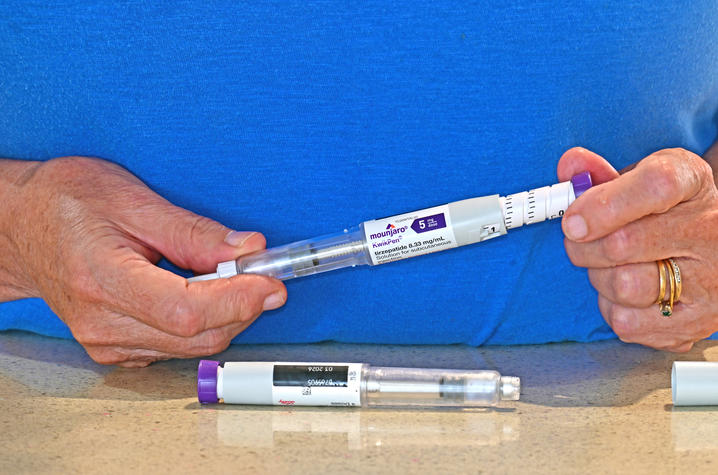The new generation of weight loss drugs: The pros and cons of GLP-1s

The University of Kentucky Public Relations and Strategic Communications Office provides a weekly health column available for use and reprint by news media. This week’s column is by the UK College of Pharmacy Chief Practice Officer Brooke Hudspeth, Pharm.D.
LEXINGTON, Ky. (Aug. 18, 2025) – You’ve likely heard about glucagon-like peptide-1 agonists — commonly referred to as GLP-1 medications, and more widely recognized through pharmaceutical brand names like Ozempic and Mounjaro.
Although those well-known brands of these medications are relatively new, GLP-1 analogs have been around for 20 years. In 2005, the Food and Drug Administration approved the first-ever GLP-1 agonist, exenatide (Byetta). Since then, several others have followed, including dulaglutide (Trulicity), liraglutide (Victoza, Saxenda), semaglutide (Ozempic, Wegovy), and the latest FDA-approved medication, tirzepatide (Mounjaro, Zepbound).
With semaglutide and tirzepatide gaining the most media attention and curiosity in recent years due to their high effectiveness, we’ll focus on these two medications.
What do these medications do?
GLP-1 is a hormone that occurs naturally in your body — it’s created by your own small intestine. It serves several functions, including:
- Triggering your pancreas to release insulin, which lowers blood sugar
- Suppressing glucagon, a hormone that raises blood sugar
- Slowing down your digestion
- Increasing your feelings of fullness after eating
GLP-1 medications mimic this natural hormone by binding to GLP-1 receptors in the body, and they are intended to be used alongside a healthy diet and exercise. By helping to regulate blood sugar, these medications support the management of Type 2 diabetes. Other effects of these medications often lead to weight loss.
What’s the difference between these two drugs?
Ozempic is the name-brand version of weekly injectable semaglutide that is FDA-approved for diabetes treatment, while Wegovy is the same injectable approved for obesity treatment. A daily oral (pill) version of semaglutide, Rybelsus, was approved for type 2 diabetes treatment in 2019.
Mounjaro is the name brand of tirzepatide approved for diabetes treatment. Meanwhile, Zepbound is the same drug formulation for treatment of both obesity and/or obstructive sleep apnea. Tirzepatide is taken in a once-weekly injection. Additionally, tirzepatide actually mimics two hormones produced in the body — in addition to being a GLP-1 agonist, it activates the glucose-dependent insulinotropic polypeptide hormone receptors.
A recent New England Journal of Medicine study showed that although both these new drugs are highly effective, tirzepatide was shown to be more effective for weight loss, possibly because of the combination of these two hormone agonists when compared to the single hormone agonist in semaglutide.
What are the side effects of these drugs?
Although GLP-1 agonists have many positive benefits, they do have a number of potential side effects.
The most common side effects include:
- Gastrointestinal issues, like constipation, diarrhea, nausea and vomiting, due to the medication’s effect on digestion.
- Cosmetic changes, including hair loss, muscle loss, loose or sagging skin, and more pronounced wrinkles. The term “Ozempic face” has been used to describe these changes, but the effects are due to rapid weight loss, not the medications themselves.
- Increased heart rate. Several GLP-1s are beneficial to heart health, but some patients report a slightly elevated heart rate while on them.
- Injection site reactions.
Though not common, some side effects of these medications can be severe. These include:
- Gallstones and gallbladder issues, thought to be caused by rapid weight loss
- Pancreatitis — studies have shown a higher risk for this condition while taking GLP-1 medications compared to other weight loss medications
- Gastroparesis (delayed stomach emptying) — though these medications are designed to slow down digestion, if it slows down too much, it can lead to other symptoms and complications.
- Kidney damage, typically resulting from dehydration caused by other side effects
- A potential risk of thyroid cancer — animal studies have shown an increased risk for thyroid C-cell tumors, though that risk has not yet been confirmed in humans.
GLP-1 medications can be a powerful tool for people to improve their health, but they’re not for everyone. They require a prescription, and it’s important to speak with a trusted health care provider to discuss your personal goals, medical history and health risks before taking them.
UK HealthCare is the hospitals and clinics of the University of Kentucky. But it is so much more. It is more than 10,000 dedicated health care professionals committed to providing advanced subspecialty care for the most critically injured and ill patients from the Commonwealth and beyond. It also is the home of the state’s only National Cancer Institute (NCI)-designated Comprehensive Cancer Center, a Level IV Neonatal Intensive Care Unit that cares for the tiniest and sickest newborns and the region’s only Level 1 trauma center.
As an academic research institution, we are continuously pursuing the next generation of cures, treatments, protocols and policies. Our discoveries have the potential to change what’s medically possible within our lifetimes. Our educators and thought leaders are transforming the health care landscape as our six health professions colleges teach the next generation of doctors, nurses, pharmacists and other health care professionals, spreading the highest standards of care. UK HealthCare is the power of advanced medicine committed to creating a healthier Kentucky, now and for generations to come.




